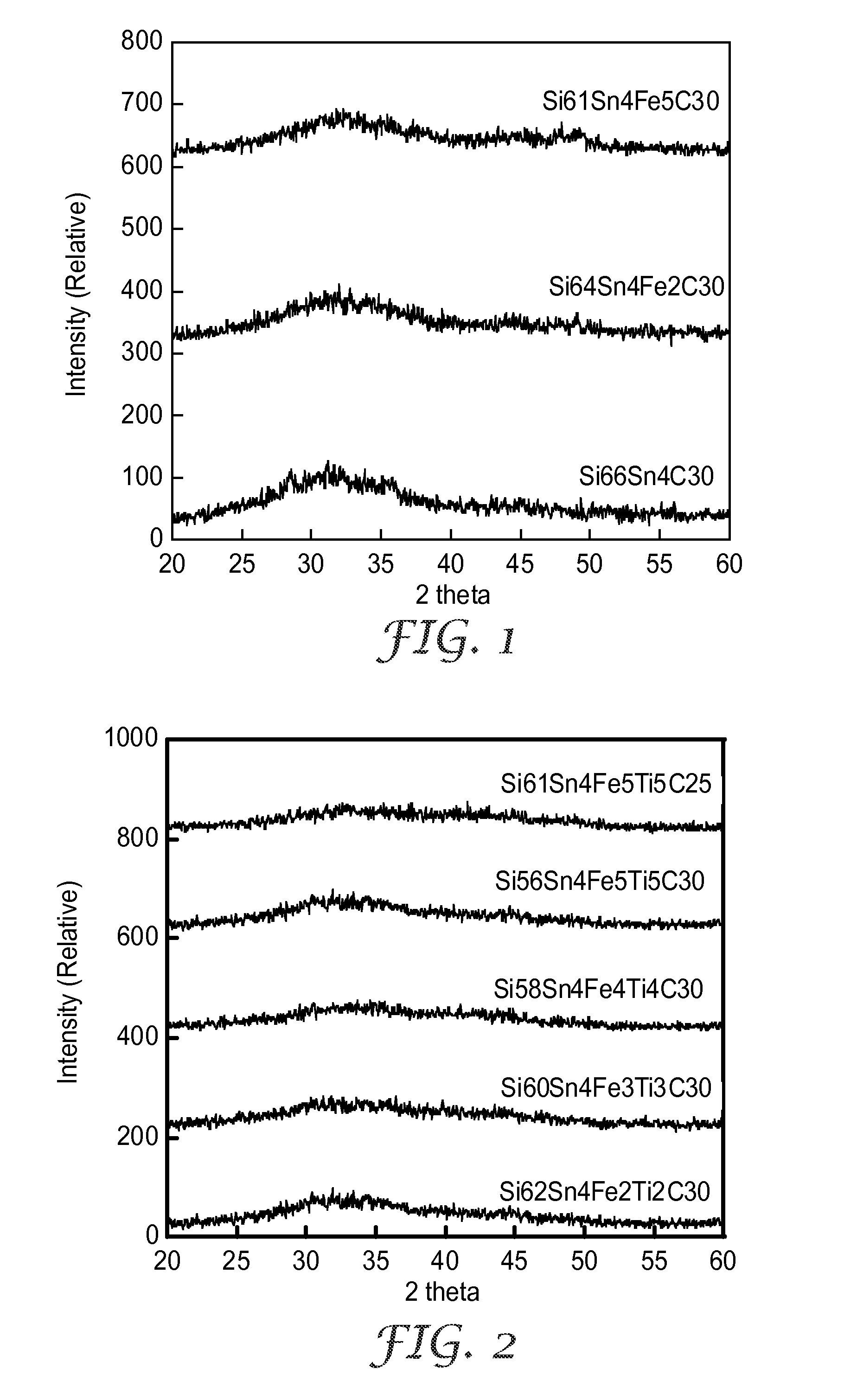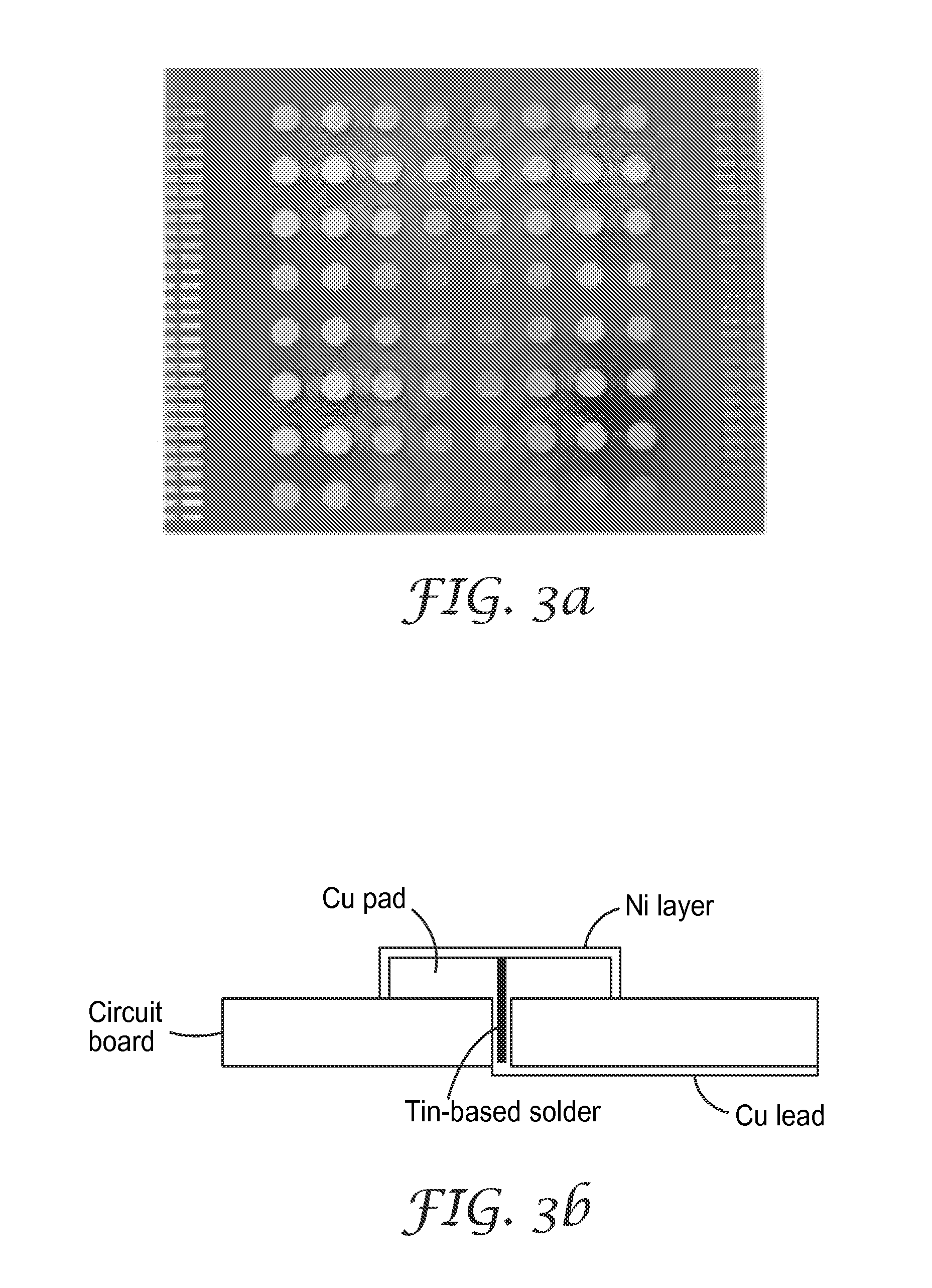Amorphous alloy negative electrode compositions for lithium-ion electrochemical cells
- Summary
- Abstract
- Description
- Claims
- Application Information
AI Technical Summary
Benefits of technology
Problems solved by technology
Method used
Image
Examples
examples 1-3
Amorphous Si66-xSn4FexC30
[0047]Raw Materials
[0048]Silicon (Si)—coarse powder, 99.8% purity, available from Elkem (Majorstua, Norway).
[0049]Tin (Sn)—325 mesh, 99.8% purity, available from Alfa Asear (Ward Hill, Mass.).
[0050]FeSi50—ferrosilicon, 50 weight percent silicon, <1.5 mm, available from Globe
[0051]Metallurgical (Beverly, Ohio).
[0052]TiSi2—325 mesh, 99.5% purity, available from Alfa Aesar.
[0053]C (graphite)—TIMREX SFG-44, available from TimCal Ltd (Bodio, Switzerland).
[0054]Appropriate amounts of raw materials (see Table 1) were added to a 5L steel vessel (internal diameter of 7.4 in (18.3 cm)) along with 10 kg of 0.5 inch (1.25 cm) diameter chromium steel balls. The vessel was purged with N2 and milled at 98 rpm (revolutions per minute) for 10 days.
TABLE 1Alloy Compositions (Si66−xSn4FexC30)Exam-AlloyStearicpleCompositionSiSnFeSi50CAcid1Si66Sn4C3068.94 g17.66 g 0 g13.40 g0.30 g2Si64Sn4Fe2C3061.67 g16.78 g 7.92 g13.12 g0.30 g3Si61Sn4Fe5C3051.30 g16.77 g19.21 g12.73 g0.30 g
[...
examples 4-7
Amorphous Si66-2ySn4FeyTiyC30
[0056]Appropriate amounts of raw materials (see Table 1) were added to a 5L steel vessel (internal diameter of 7.4 in (18.3 cm)) along with 10 kg of 0.5 inch (1.25 cm) diameter chromium steel balls. The vessel was purged with N2 and milled at 98 rpm (revolutions per minute) for 13 days.
TABLE 2Alloy Compositions (Si66−2ySn4FeyTiyC30)ExampleAlloy CompositionSiSnFeSi50TiSi2CStearic Acid4Si62Sn4Fe2Ti2C3054.74 g17.04 g 7.81 g7.47 g12.94 g1.00 g5Si60Sn4Fe3Ti3C3048.00 g16.75 g11.51 g11.02 g12.72 g1.00 g6Si58Sn4Fe4Ti4C3041.49 g16.47 g15.09 g14.44 g12.50 g1.00 g7Si61Sn4Fe5Ti5C2515.77 g15.77 g18.08 g17.28 g 9.97 g1.00 g
[0057]FIG. 2 shows X-ray diffraction (XRD) patterns of the alloy powders of Examples 4-7 made from the compositions in Table 2. The XRD plots showed no definite peaks indicating that all of the alloys were amorphous.
Testing Alloys as Active Material for Reversible Lithiation / Delithiation
Binder Formulation
[0058]Poly(acrylic acid)-Li Salt (designed ...
PUM
| Property | Measurement | Unit |
|---|---|---|
| Mass | aaaaa | aaaaa |
| Mass | aaaaa | aaaaa |
| Mole fraction | aaaaa | aaaaa |
Abstract
Description
Claims
Application Information
 Login to View More
Login to View More - R&D
- Intellectual Property
- Life Sciences
- Materials
- Tech Scout
- Unparalleled Data Quality
- Higher Quality Content
- 60% Fewer Hallucinations
Browse by: Latest US Patents, China's latest patents, Technical Efficacy Thesaurus, Application Domain, Technology Topic, Popular Technical Reports.
© 2025 PatSnap. All rights reserved.Legal|Privacy policy|Modern Slavery Act Transparency Statement|Sitemap|About US| Contact US: help@patsnap.com



